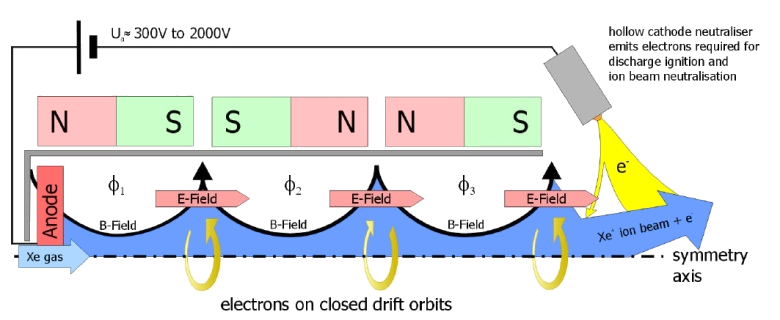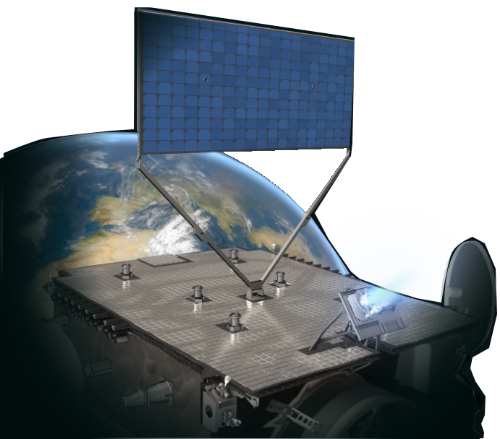The HEMPT-NG2 project
The HEMPT-NG2 project addresses the topic SPACE-28-TEC-2020 on Incremental Technologies which is part of the SRC - In-Space electrical propulsion and station keeping. It will contribute to the principal target of the EPIC roadmap “to increase the competitiveness of the EP systems developed in Europe” by developing an integrated solution based on HEMPT (Highly Efficient Multistage Plasma Thruster) for the thruster, the fluidic management system, and the power processing unit.
Final products
The final products consist of modular elements, which can be put together to an EPS ideally suited to the specific needs for LEO applications with an accessible power range of 200W to 700 W. The thruster module is capable of dual-optimized mode operations allowing orbit raising and station keeping with the same EPS or to select prior launch an ideal working point for the specific mission.
The HEMPT technology used in this project offers unique features compared to other EP technologies:
The HEMPT-NG2 project addresses the topic SPACE-28-TEC-2020 on Incremental Technologies which is part of the SRC - In-Space electrical propulsion and station keeping. It will contribute to the principal target of the EPIC roadmap “to increase the competitiveness of the EP systems developed in Europe” by developing an integrated solution based on HEMPT (Highly Efficient Multistage Plasma Thr...
- No discharge channel erosion leading to higher lifetimes of the thrusters
- High acceleration voltages enabling a high specific Impulse (ISP) leading to a drastic reduction of propellant consumption
- Minimal complexity of the principal technological concept providing an excellent basis for economic competitiveness
Functional Principle of the HEMPT technology
A HEMP-Thruster generates its thrust by the acceleration of gas ions in an electric field formed as a result of an electrical potential between the anode and the cathode of the neutralizer. The ions are generated in a dielectric plasma discharge channel and are confined by a system of periodically arranged permanent magnets. The magnetic field topology efficiently minimizes electron losses on the discharge channel walls and therefore erosion phenomena with the result of enhanced lifetime. The anode with the propellant gas inlet is mounted at the upstream end of the discharge channel, and the neutralizer cathode for ignition and neutralization of the ion beam is placed at the downstream end.

Work logic of the Second Hempt phase
The objective for this second phase is to support the more promising technologies developed in Phase 1 towards higher TRLs and taking into account the optimization of the recurring costs during the design phase in order, at the end of the Phase 2, to achieve the SRC expectations: 1. to be ready to be chosen for a potential IOD/IOV, and 2. to allow the developed EPS products to become competitive on the electric propulsion market at world level within the 2020-2030 timeframe.
The project will follow a strict work logic. The LEO EPS will be qualified up to TRL 6-7 through environmental qualification, endurance testing and coupling tests:
The objective for this second phase is to support the more promising technologies developed in Phase 1 towards higher TRLs and taking into account the optimization of the recurring costs during the design phase in order, at the end of the Phase 2, to achieve the SRC expectations: 1. to be ready to be chosen for a potential IOD/IOV, and 2. to allow the developed EPS products to become competi...
- Maturation and finalization of the design to be ready for CDR
- Setup / Provision of (Engineering) Qualification Models
- Qualification on unit level for relevant environment
- Endurance Testing on Thruster Module Level to demonstrate Lifetime supported by Lifetime analysis.
- System Level Tests such as Functional and EMC testing
The HEMPT-Technology provides unique advantages
The consortium is set up in a way that the HEMPT-NG2 project directly involves the users of the product during the development of this technology. Traditional competitors work together across frontiers between satellite primes. It is therefore ensured that the product is optimized for its final market, all-electric satellites for LEO applications enabling world-wide internet access.
The patented European HEMPT-Technology in comparison to the competing technologies provides unique advantages such as:
The consortium is set up in a way that the HEMPT-NG2 project directly involves the users of the product during the development of this technology. Traditional competitors work together across frontiers between satellite primes. It is therefore ensured that the product is optimized for its final market, all-electric satellites for LEO applications enabling world-wide internet access.
The p...
- Lowest system complexity due to the simplicity of the concept which will allow
- maximal reduction of cost and mass,
- Long lifetime by concept,
- Flexibility to provide high thrust operation and very precise low thrust operation with the same engine
- Operation of the same unit in different operating regimes (dual voltage) maximizing the propellant savings and giving flexibility for new failure recovery strategies.
HEMPT development activities to the LEO application field of electric propulsion systems
Improvement and extension of performance of the EPS and its constituents to reach the capabilities demanded by the work programme and to satisfy the market need
Reduction of complexity on component and system level including testing and documentation to improve competitiveness in order to achieve significant cost reductions
Implementation of new features and technologies to enable better trade-offs at spacecraft level improving the overall performance and economic efficiency also at spacecraft level
Improving technology maturity (TRL6-7 and preparing to reach the final technological maturity and the market entry by or directly after the end of the project.
The HEMPT-NG2 Consortium






Recent Conferences and Workshops
| Space Propulsion 2020+1 | 100% Virtual | 17. - 19. March 2021 | Workshop programme |
| IVEC - International Vacuum Electronics Conference | 100% Virtual | 28. - 30. April 2021 | Conference Website |
Recent Scientific Publications
Plasma Sources Science and Technology
Contributions to Plasma Physics
36th International Electric Propulsion Conference

